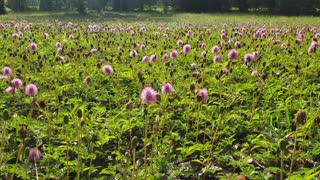Premium Only Content

Mimosa pudica
There are over 300 species of Mimosa that belong to the bean (pea) family Leguminosae. This species, Mimosa pudica, is native to Brazil but is naturalized throughout the tropics of the Americas, Africa, and Asia. It runs wild as a weed in the Gulf States.
Mimosa pudica is a perennial but is often cultivated as an annual in gardens. The shrubby plant will grow to 18 inches outdoors with hairy and spiny stems. Its flowers resemble little purplish puffs that give rise to ½ inch-long pods containing 3 – 4 seeds This small species should not be confused with the hardy outdoor tree Albizia julibrissin, commonly called Mimosa or Silk tree.
Mimosa pudica is remarkable because of its:
bullet Nyctinastic movements - in the evening the leaflets fold together and the whole leaf droops downward until sunrise.
bullet Seismonastic movements - touching the leaves, or shaking the plant, or slight warming of the leaves, or chemical and electrical stimuli, or subjecting the plant to a lack of water, will cause the leaflets to fold together and the whole leaf to droop downwards temporarily.
Movements by plants have fascinated people since the days of ancient Greece. Written accounts describing movement by a plant (probably a species of Mimosa) in response to touch have been documented to be over 2000 years old. Although viewed as an interesting phenomenon for many years, a serious investigation into these movements was not started until the 19th century when it was discovered that the movements are the result of a rapid loss of pressure in strategically situated cells that cause the leaves to droop right before one’s eyes. This evidence led to the rejection of the then widely held hypothesis that Mimosa pudica plants had nerve and muscle tissues similar to those found in animals.
The exact mechanism of how the specialized cells in the pulvini of the leaves lose their internal pressure (turgor pressure) to cause leaf movement has not been discovered. However, researchers have found that as the leaves are stimulated to fold together and droop downward, changes in membrane permeability of the cells in the pulvini occur that allow for the rapid movement of calcium ions. This has been related to increased cell wall pliability in the pulvini, which when coupled with decreased turgor pressure allows for movement.
The stimulus to fold and droop leaves can be transmitted from one part of the plant to another. Upon stimulation, changes in electrical potential progress from the site of stimulation to other parts of the plant. In addition, an as of yet unidentified chemical transmitter substance (hormone) can also be measured to move from the site of stimulation to distant parts of the plant.
No one has tied all these bits of information together to come up with a plausible, all encompassing hypothesis to explain the movement of Mimosa pudica leaves, but a number of researchers around the world are actively working on this mystery.
We can only guess as to why Mimosa pudica and a few other species have evolved to exhibit nyctinastic and seismonastic movements. It has been observed that folded and drooped leaves are not attractive to herbivores, and are often passed by in favor of more normal appearing leaves to eat. Also, folded and drooped leaves exchange less heat and water than fully expanded leaves, and this might have some survival value when the plants are under environmental stress.
-
 0:15
0:15
WochitNow
3 years agoMIMOSA
10 -
 0:20
0:20
rexacrouch
3 years agoBees Find Sunrise Mimosa
18 -
 9:21
9:21
Herbal Medicine 101
3 years ago $0.15 earnedHerbal Medicine 101, Lesson 21: Mimosa
8615 -
 0:56
0:56
ItalianRecipes
4 years agoENG - Linguine mimosa
29 -
 0:33
0:33
aw23981o
4 years agoGlossed over mimosa
752 -
 0:29
0:29
KiwiLimon_SeasonalRecipes_English
4 years ago $0.01 earnedClassic Mimosa
381 -
 0:26
0:26
KiwiLimon_SeasonalRecipes_English
4 years agoStrawberry Mimosa
11 -
 0:53
0:53
KiwiLimon_SeasonalRecipes_English
4 years ago $0.01 earnedTropical Mimosa
9 -
 2:40
2:40
KiwiLimon_SeasonalRecipes_English
4 years agoMimosa with Mandarin Snow
5 -
 1:24:56
1:24:56
Quite Frankly
23 hours ago"Wild Tales: Crazy Story Hotline" | The Brothers Ep. 1
111K16